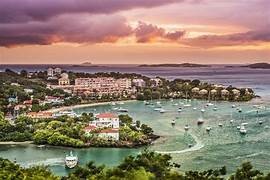The Unique Flora and Fauna of Saint John US Virgin Island

Exploring the Unique Flora and Fauna of Saint John US Virgin Island
The beautiful island of Saint John in the US Virgin Islands is home to a unique and diverse array of flora and fauna. From the lush green hillsides to the crystal clear waters of the Caribbean Sea, the island is a paradise for nature lovers.
The island is home to a variety of plants and animals, including some that are found nowhere else in the world. The most iconic of these is the endangered St. John tree boa, which is found only on the island. This beautiful snake is a sight to behold, with its bright yellow and green scales and its long, slender body.
The island is also home to a variety of birds, including the endangered St. John parrot. This colorful bird is a favorite of birdwatchers, as it is often seen perched atop trees or flying around the island.
The waters around the island are home to a variety of marine life, including sea turtles, dolphins, and a variety of fish. The coral reefs around the island are also home to a variety of colorful fish and other marine life.
The island is also home to a variety of unique plants, including the endangered St. John’s wort, which is found only on the island. This plant is a favorite of gardeners, as it produces beautiful yellow flowers that attract butterflies and hummingbirds.
The island of Saint John is a paradise for nature lovers, with its unique flora and fauna. From the endangered St. John tree boa to the colorful St. John parrot, the island is home to a variety of unique species that can be found nowhere else in the world. Whether you’re a birdwatcher, a gardener, or just someone who loves nature, Saint John is the perfect place to explore and appreciate the beauty of nature.
The Endangered Species of Saint John US Virgin Island
The Saint John US Virgin Island is home to a variety of endangered species, including the Hawksbill Sea Turtle, the Caribbean Monk Seal, and the St. John Tree Boa. Each of these species is unique and has a fascinating story to tell.
The Hawksbill Sea Turtle is a critically endangered species that is found in the waters around Saint John. It is a beautiful creature, with a shell that is patterned with yellow, brown, and black. The Hawksbill Sea Turtle is an important part of the local ecosystem, as it helps to keep coral reefs healthy by eating sponges and other organisms that can damage the coral. Unfortunately, the Hawksbill Sea Turtle is threatened by habitat destruction, poaching, and pollution.
The Caribbean Monk Seal is another endangered species that is found in the waters around Saint John. This species is the only seal native to the Caribbean and is one of the most endangered marine mammals in the world. The Caribbean Monk Seal is a shy creature that prefers to stay away from humans, but it is an important part of the local ecosystem. Unfortunately, the Caribbean Monk Seal is threatened by habitat destruction, fishing, and pollution.
The St. John Tree Boa is a unique species of snake that is found only on Saint John. This species is a beautiful creature, with a pattern of yellow, brown, and black scales. The St. John Tree Boa is an important part of the local ecosystem, as it helps to keep the insect population in check. Unfortunately, the St. John Tree Boa is threatened by habitat destruction and illegal pet trade.
These three species are just a few of the many endangered species that call Saint John home. Each of these species has a unique story to tell and is an important part of the local ecosystem. We must do our part to protect these species and ensure that they are able to thrive in their natural habitats.
The Role of Conservation in Protecting the Flora and Fauna of Saint John US Virgin Island
The beautiful island of Saint John in the US Virgin Islands is home to a diverse array of flora and fauna. From the lush green hillsides to the crystal clear waters, the island is a haven for wildlife. Conservation efforts have been essential in protecting the island’s unique biodiversity.
The Virgin Islands National Park, established in 1956, is the largest protected area on the island. It covers two-thirds of the island and is home to a variety of species, including the endangered hawksbill sea turtle. The park is managed by the National Park Service, which works to protect the island’s natural resources and promote sustainable tourism.
The Virgin Islands Conservation Society (VICS) is another important organization working to protect the island’s flora and fauna. Founded in 1971, VICS works to protect the island’s coral reefs, mangroves, and other habitats. The organization also works to educate the public about the importance of conservation and sustainable development.
The Friends of the Virgin Islands National Park is another important organization working to protect the island’s natural resources. The organization works to promote the park’s conservation efforts and to raise funds for research and education.
The US Fish and Wildlife Service is also involved in conservation efforts on the island. The agency works to protect endangered species, such as the hawksbill sea turtle, and to promote sustainable fishing practices.
The efforts of these organizations have been essential in protecting the island’s unique flora and fauna. Through their work, they have helped to ensure that the island’s natural resources are preserved for future generations. Conservation is an important part of protecting the island’s biodiversity and ensuring that its unique wildlife is protected.
